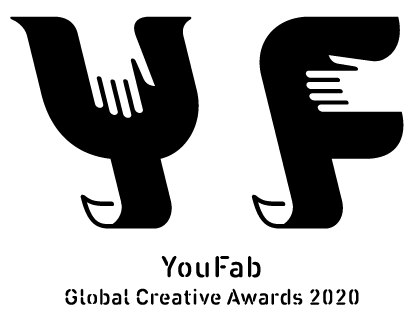-
Work Title
HERMITS
-
Work Title(EN)
HERMITS
-
Please describe the concept of your artwork in 1000 words.
Project HERMITS explores a way to greatly advance the versatility of Robotic Tangible Interfaces. Inspired by hermit crabs as well as the 'shell' of Computer Architecture, we designed a modular system for table-top wheeled robots to dock to passive attachment modules, defined as "mechanical shells." Different types of mechanical shells can uniquely extend and convert the motion of robots with embedded mechanisms, so that, as a whole architecture, the system can offer a variety of interactive functionality by self-reconfiguration. We envision this novel interactive architecture to bring a rich application space including physical space organization, digital data physicalization, and entertainment/storytelling systems.
The general approach in HERMITS expands how physical interfaces and computers in our daily life can adapt and reconfigure for user interactions with passive attachments. We are in the age where robotic systems are emerging in our living space (e.g. robotic vacuum cleaner, drones). The idea presented in HERMITS has greater implications beyond our prototype, where everyday robotic systems may gain a significant amount of functionality, expressivity, and interactivity by switching mechanical shells. -
Please describe the concept of your artwork in 1000 words. (EN)
Project HERMITS explores a way to greatly advance the versatility of Robotic Tangible Interfaces. Inspired by hermit crabs as well as the 'shell' of Computer Architecture, we designed a modular system for table-top wheeled robots to dock to passive attachment modules, defined as "mechanical shells." Different types of mechanical shells can uniquely extend and convert the motion of robots with embedded mechanisms, so that, as a whole architecture, the system can offer a variety of interactive functionality by self-reconfiguration. We envision this novel interactive architecture to bring a rich application space including physical space organization, digital data physicalization, and entertainment/storytelling systems.
The general approach in HERMITS expands how physical interfaces and computers in our daily life can adapt and reconfigure for user interactions with passive attachments. We are in the age where robotic systems are emerging in our living space (e.g. robotic vacuum cleaner, drones). The idea presented in HERMITS has greater implications beyond our prototype, where everyday robotic systems may gain a significant amount of functionality, expressivity, and interactivity by switching mechanical shells. -
Work Specification
The overall system of HERMITS includes the (1) robots, (2) mechanical shells, (3) an interaction stage, and (4) a computer to control the system, as shown in the figure. By using a computer to control the robots to dock, un-dock and control the mechanical shells, the system provides reconfigurable rich interactivity to users.
Our prototype system of HERMITS is based on an off-the-shelf robotic toy, toio, a two-wheeled robotic system. We have built a Raspberry Pi-based hierarchical control architecture. A computer takes central control of the system, while a number of Raspberry Pi micro-controllers were used for connecting and controlling individual toios through Bluetooth (based on Python code).
To achieve the active docking, we have modified the toio hardware with an additional vertically moving pin enabled by a micro-linear servo motor. This pin was designed to dock to a slot of mechanical shell for robust connection and motion transmission.
Every prototype of Mechanical Shells was developed based on four primitive CAD data, which has different features to convert and extend the robotic device. The mechanical shells were 3D printed and manually assembled. -
Work Specification(EN)
The overall system of HERMITS includes the (1) robots, (2) mechanical shells, (3) an interaction stage, and (4) a computer to control the system, as shown in the figure. By using a computer to control the robots to dock, un-dock and control the mechanical shells, the system provides reconfigurable rich interactivity to users.
Our prototype system of HERMITS is based on an off-the-shelf robotic toy, toio, a two-wheeled robotic system. We have built a Raspberry Pi-based hierarchical control architecture. A computer takes central control of the system, while a number of Raspberry Pi micro-controllers were used for connecting and controlling individual toios through Bluetooth (based on Python code).
To achieve the active docking, we have modified the toio hardware with an additional vertically moving pin enabled by a micro-linear servo motor. This pin was designed to dock to a slot of mechanical shell for robust connection and motion transmission.
Every prototype of mechanical shells was developed based on four primitive CAD data, which has different features to convert and extend the robotic device. The mechanical shells were 3D printed and manually assembled. -
Media CoverageURL
https://www.media.mit.edu/projects/hermits/overview/
-
Video URL
https://vimeo.com/468288719
-
Your OfficialURL (Website, Instagram, Facebook)
ken-nakagaki.com
-
Your Profile
Ken is an interaction designer and HCI researcher from Japan. Currently, he is a Ph.D. Candidate of Tangible Media Group, MIT Media Lab. He is interested in developing interfaces that combine digital information or computational aids into daily physical tools and materials, to develop novel physical and perceptual experiences. His research has been presented in top HCI conferences (ACM CHI, UIST, TEI, etc), and demonstrated in various exhibitions and awards including Ars Electronica, A' Design Award, and Japan Media Arts Festival.
-
Team Members
Ken Nakagaki: Project Lead
Joanne Leong: System Design and Paper Support
Jordan L Tappa: Fabrication and Design Support (MIT UROP)
Joao Wilbert: System Design Support
Prof. Hiroshi Ishii: Project Advisor -
Entrant’s location (Where do you live?)
Cambridge, MA, USA
- 228
HERMITS
Project HERMITS explores a way to greatly advance the versatility of Robotic Tangible Interfaces. Inspired by hermit crabs as well as the 'shell' of Computer Architecture, we designed a modular system for table-top wheeled robots to dock to passive attachment modules, defined as "mechanical shells." Different types of mechanical shells can uniquely extend and convert the motion of robots with embedded mechanisms, so that, as a whole architecture, the system can offer a variety of interactive functionality by self-reconfiguration. We envision this novel interactive architecture to bring a rich application space including physical space organization, digital data physicalization, and entertainment/storytelling systems.


